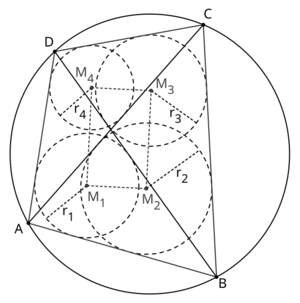Japanese Theorem
The Japanese theorem exists for both cyclic quadrilaterals and cyclic polygons.
Contents
[hide]Japanese theorem for cyclic quadrilaterals
Definition
The Japanese theorem for cyclic quadrilaterals states that for a cyclic quadrilateral ![]() and incenters
and incenters ![]() ,
, ![]() ,
, ![]() ,
, ![]() of triangles
of triangles ![]() ,
, ![]() ,
, ![]() ,
, ![]() the quadrilateral
the quadrilateral ![]() is a rectangle.
is a rectangle.
Proof
From ![]() , we can see that
, we can see that
![]()
Similarly, from ![]() we have
we have
![]()
Since ![]() is cyclic, therefore
is cyclic, therefore ![]() , which means that
, which means that
![]()
From this, it follows that ![]() is cyclic. This means that
is cyclic. This means that
![]()
By symmetry, we can also derive
![]()
Adding these equations up, we get
![]()
![]()
Which implies
![]()
And other angles similarly.
![]()
Japanese theorem for cyclic polygons
Definition
The Japanese theorem for cyclic polygons states that for any triangulated cyclic polygon, the sum of the inradii of the triangles is constant.










